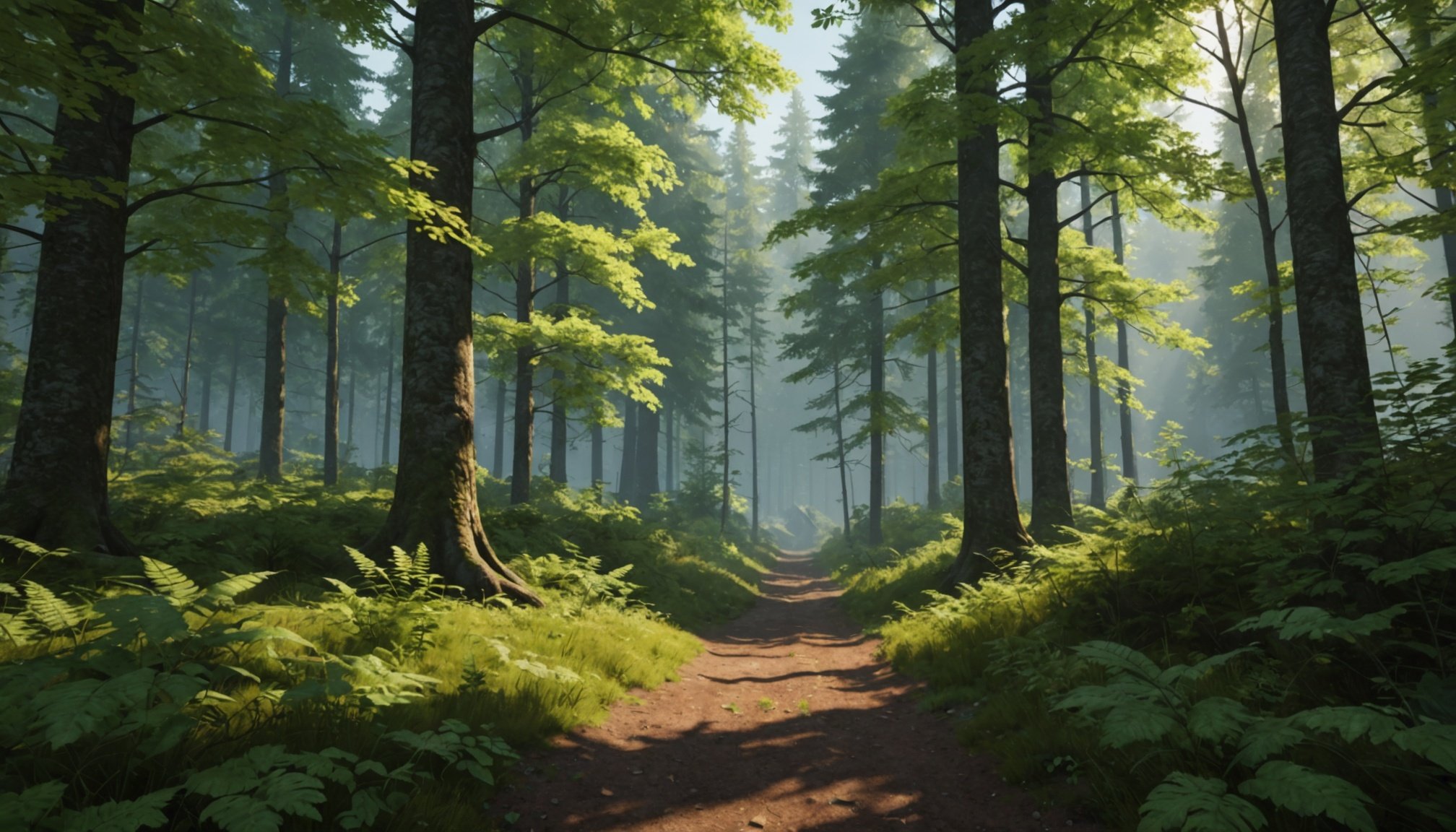Advanced Techniques for Realistic Foliage Creation
Creating realistic foliage is an intricate aspect of forest game development that enhances the player’s immersive experience. Utilizing essential realistic foliage techniques is crucial for lifelike game environments.
One significant technique involves understanding the key differences between 2D and 3D foliage modeling. In 2D modeling, artists use flat textures on planes to simulate foliage, which is less resource-intensive and suited for distant views. Meanwhile, 3D foliage modeling offers depth and realism, essential for close-up interactions, although it demands more computational power. This distinction helps developers choose the right approach based on their game environment needs and constraints.
In parallel : Top Strategies for Seamless Real-Time Voice Modulation in Multiplayer Gaming
In forest games, the importance of foliage density cannot be overstated. Dense foliage enhances visual reality, providing complexity and depth to forests. Variety in foliage types—ranging from trees and bushes to undergrowth—adds richness and authenticity. An artist might employ a combination of procedural generation and manual detailing to achieve this. These advanced techniques ensure that players encounter diverse, lively ecosystems, reflecting the natural world’s complexity. By mastering these realistic foliage techniques, developers can significantly boost their game’s visual and experiential appeal.
Practical Tutorials for Foliage Development
Navigating the creation of lifelike foliage can be daunting in game art. Our Foliage Tutorials aim to guide you through this process.
In parallel : Mastering Intuitive Gesture Controls: Top Strategies for Engaging AR Game Design
Step-by-Step Guide to Creating 3D Trees
Creating 3D trees involves various stages, beginning with selecting a reliable modeling software, such as Blender or Maya. Begin with crafting the tree trunk, utilising tools to define the bark’s texture. Following this, shape the branches, ensuring naturalistic divergence. Leveraging polygonal shapes or splines can enhance details and realism in the branches. After modelling, the transition to texturing entails creating UV maps, essential for accurate texture placement. This step ensures your trees possess an authentic appearance in any lighting.
Implementing Custom Textures for Leaves
To create realistic game art, implementing custom leaf textures is vital. Start by capturing high-resolution leaf images or designing them from scratch in tools like Photoshop. Then, refine these into texture patterns. Applying these textures requires proficiency in shaders, allowing for variations in translucency and shadow, which adds depth and vitality.
Techniques for Realistic Ground Cover
To achieve realistic ground cover, begin by examining various plant species to replicate in your art. Use reference images to inform your design. Integrate a mix of grass, small plants, and fallen leaves for variability. Employ particle systems or scattering tools within your software to distribute these assets organically across your environment.
Successful Implementations of Foliage in Games
Successful integration of foliage in games elevates the immersive experience, offering players a sense of realism and connection with the virtual environment. Noteworthy games, such as The Witcher 3: Wild Hunt and Red Dead Redemption 2, have become iconic for their exceptional use of foliage. In these games, foliage enhances not just visual fidelity but also gameplay immersion by creating dynamic, living worlds that respond to player actions and environmental changes.
Industry professionals often highlight the importance of foliage in crafting believable worlds. For example, in The Witcher 3, the swaying trees and rustling grass contribute to the ambiance, inviting players to lose themselves in the expansive landscapes. These foliage details, although minute, significantly impact the player’s sense of presence within the game.
Insights from developers reveal strategies such as using procedural generation to ensure lush environments without excessive resource requirements. Additionally, attention to details like varied plant species and weather-responsive vegetation can dramatically improve realism and depth. Foliage is not just an aesthetic choice; it’s a fundamental element of storytelling and gameplay that requires thoughtful implementation to achieve a compelling and engaging player experience.
Recommended Tools and Software for Foliage Creation
Creating realistic foliage is a complex task in game development. To achieve stunning visuals, developers rely on specialized foliage tools and game development software.
Overview of Top Software for Foliage Design
When it comes to foliage design, Unreal Engine and Unity are among the top choices. Both platforms provide robust foliage editors. Unreal Engine offers Foliage Tools with the Landscape System, allowing designers to craft expansive, interactive environments. Unity, on the other hand, provides the Terrain System, which is ideal for game developers seeking simplicity and flexibility in creating natural landscapes.
Comparing Real-time Rendering Tools
Real-time rendering tools such as SpeedTree and PlantFactory excel in game development. SpeedTree is celebrated for its procedural generation capabilities and seamless integration with engines like Unity. PlantFactory is renowned for its detailed vegetation modeling and versatility. Choosing the right tool depends on specific project needs, from speed to complexity.
Best Practices for Asset Management
Efficient management of foliage assets is crucial. Best practices include:
- Organizing assets into logical hierarchies and categories.
- Utilizing asset pooling techniques to minimize memory usage.
- Implementing naming conventions for easy retrieval.
Adopting these strategies can significantly enhance workflow and optimize game performance.
The Role of Foliage in Gameplay and Immersion
Foliage in video games does more than just beautify landscapes—it plays a crucial role in enhancing game immersion. The presence of lush trees, waving grasses, and dense forests has a psychological impact on the player’s experience. Players often feel more engaged and connected to the game world as the foliage importance mirrors real-life ecosystems, encouraging a suspension of disbelief that can transform gameplay into a memorable journey.
From a gameplay mechanics perspective, foliage can significantly influence exploration. Dense bushlands and towering trees may serve as natural barriers that direct player movement. They might also conceal paths and secrets, compelling players to venture deeper into game worlds. The strategic positioning of foliage elements thus enhances exploration and discovery, which is a critical component of the overall game immersion.
Looking to the future, trends in foliage design are leaning towards increased realism, with developers harnessing advanced graphics and physics engines. The ambition is to create immersive environments where foliage responds to player interactions and environmental conditions dynamically, thereby elevating realism. Going forward, as technology advances, we can expect even more interactive and visually stunning game worlds.











